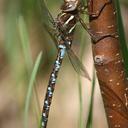United States and Canada
This brown species is marked with blue-green and distinctive pale yellow or cream-colored lateral thoracic stripes. There are two pale middorsal thoracic stripes that become obscured with age. The wings are clear with a small basal brown spot extending out to the first antenodal crossvein in each wing. The abdomen is brown with pale blue spots that become obscured in preserved specimens. Females have either blue or green spots.
Size: Total length: 50-67 mm; abdomen: 38-51 mm; hindwing: 32-42 mm.
Similar Species (south-central US): Fawn Darner (Boyeria vinosa) has two pale yellow spots on the side of the thorax and lacks blue spots on the abdomen. Harlequin (Gomphaeshna furcillata) and Taper-tailed (G. antilope) Darner both lack blue spots on the abdomen and the lateral thoracic stripes are not straight.
Habitat: Small forest lakes and streams and rivers with slow current.
Natural History: This common species is much like Fawn Darner in its habits. It is found earlier in the spring in many of the same locations that the former will visit later in the summer. They are active during the day, sometimes well into the evening. They patrol streams and lake shores with greater speed and at greater heights than Fawn Darner. Females lay eggs below the water surface in live plants and dead leaves or cattails.
Distribution: Eastern U.S. and Canada westward to Oklahoma and Texas.
Source: Abbott, J.C. 2006-2010. OdonataCentral: An online resource for the distribution and identification of Odonata. Available at OdonataCentral.
Edited by Drew Weber (9/24/2015).
